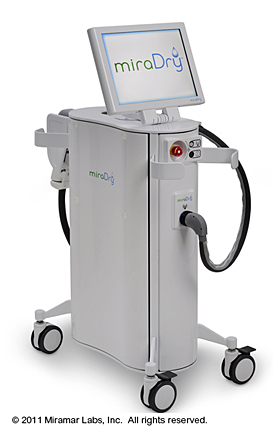

 miraDry was cleared by the U.S. FDA in 2011 and is CE-marked in Europe to treat axillary hyperhidrosis (or excessive underarm sweating). It is also now available in more than 50 countries worldwide. (Looking for miraDry near you? Use this miraDry locator).
miraDry was cleared by the U.S. FDA in 2011 and is CE-marked in Europe to treat axillary hyperhidrosis (or excessive underarm sweating). It is also now available in more than 50 countries worldwide. (Looking for miraDry near you? Use this miraDry locator).
Below you can read a lot of information about this useful treatment. We also have a webinar you can watch that is all about miraDry and answers the most common questions the hyperhidrosis community asks about how the treatment works and what to expect. Ready to watch Ask Me Anything About miraDry?
miraDry was, additionally, FDA-cleared in 2015 to permanently eliminate underarm hair of all colors as well as odor glands (which are just a different kind of sweat gland); making it the first FDA-cleared device available to halt unwanted underarm sweat and hair growth while also eliminating odor-producing glands. (For hair reduction, the device is sometimes called miraSmooth instead of miraDry.) Generally, we'll focus on miraDry's sweat-stopping capabilities. If you want more information on permanent hair-zapping, visit www.mirasmooth.com. One benefit of miraDry/miraSmooth for permanent hair removal is that, unlike laser hair removal, it works no matter what color your skin or hair is.
A study published in the Journal of Cosmetic and Laser Therapy in 2013 showed that miraDry was effective in treating both axillary (underarm) hyperhidrosis and axillary osmidrosis (foul-smelling sweat). As part of the study, 11 patients in Asia were treated with miraDry and then evaluated 7 months later for improvement of symptoms. At the follow-up, 83.3% of the underarms treated were determined to have experienced a 2-point improvement in the Hyperhidrosis Disease Severity Scale (HDSS). Among those underarms that had exhibited foul odor (osmidrosis), 93.8% showed good to excellent results.
In April 2012, clinical data from the University of British Columbia showed that miraDry was successful in reducing underarm sweat in over 90% of patients. The average sweat reduction was 82%. Patients rated their satisfaction with the treatment at 90%.
Carolyn Jacob, MD wrote the following in an article published in the March 2013 edition of peer-reviewed Seminars in Cutaneous Medicine and Surgery:
"The treatment of primary axillary hyperhidrosis can be rewarding using noninvasive microwave technology. Because the microwaves preferentially target the region of skin where the sweat glands reside, leading to localized thermolysis of the sweat glands, patients can now benefit from permanent targeted sweat reduction. The microwave treatment has been shown to be safe and effective in >6000 procedures to date."
miraDry is owned by 1315 Capital of Santa Barbara, California.
While miraDry is promising news for those who suffer from underarm sweating, the device is not yet "cleared" - or optimized - for use to treat excessive sweating of other areas such as hands or feet.
miraDry uses a non-invasive handheld device to deliver precisely controlled electromagnetic energy beneath the underarm skin to the specific area where sweat glands are located, resulting in thermolysis (decomposition by heat) of the sweat glands. While the sweat glands are being eliminated through electromagnetic technology, the top layers of the skin are simultaneously cooled and protected. Sweat glands are not believed to grow back after treatment so the effect can be seen almost immediately and results are lasting. Some patients may only need one treatment but, for best results, two procedures spaced three months apart are recommended (occasionally a third treatment may be required.)
Miramar Labs (former owners of miraDry) was the first company to gain FDA clearance to use electromagnetic energy to combat excessive sweating (by eliminating or damaging sweat glands), but the technology has been used safely in other areas of medicine for years. Established medical uses of electromagnetic energy include applications for cardiology, cosmetics, general surgery, urology, and oncology.
The miraDry procedure is performed in the clinician's office and typically takes one hour. Local anesthesia (usually lidocaine injections) will be administered before starting the treatment. Patients usually experience little to no discomfort during the procedure and there is minimal to no downtime afterward. Mild over-the-counter pain medication and ice packs are generally recommended for a few days. Most patients are able to return to normal activities or work right after the procedure, and can typically resume exercise within several days.
Common and minor side effects of miraDry include underarm swelling, redness, and tenderness lasting for several days. Numbness and tingling can occur in the upper arm or armpit and may last for about 5 weeks. It's also possible for post-inflammatory hyperpigmentation (PIH) or postinflammatory pigment alteration (skin turning lighter or darker) to occur after miraDry treatment. PIH or other skin tone changes are more likely to occur in skin of color. PIH happens when skin makes extra melanin after it has been irritated or injured. Melanin is a natural pigment responsible for color in our hair, skin, and eyes. Skin cells can react to irritation by making extra melanin, which leads to post-inflammatory hyperpigmentation. This skin condition shows up as tan, brown, dark brown, or even blue-gray patches or spots on the skin. Areas of hyperpigmentation can fade on their own without treatment (over 6-12 months) but a dermatologist can also help speed up the process with treatments like skin lighteners, retinoids, or chemical peels. If you are concerned about the risk of skin color alterations with miraDry, discuss this with your healthcare provider in advance.
Some important additional notes: A miraDry representative told us that "it's normal" that immediately after treatment there will be no sweat at all in the area treated (100% dry). After 2 to 3 weeks, though, some sweating will return. This change in sweating output is due to post-treatment swelling and its dissipation. The amount of long-term sweat reduction achieved via miraDry treatment is very personal. On average for hyperhidrosis patients, after two treatments, sweat is reduced by 82%. Some patients needing more sweat reduction could benefit from a third treatment. But before a third treatment, a healthcare professional should conduct a simple starch iodine test to determine where the remaining sweating is coming from. This will make the third treatment more targeted. Very rarely, a person may have some sweat glands that are either too deep or too shallow for the microwave energy to reach (the microwave energy works in a zone 2mm to 5mm below the skin's surface, where most sweat glands reside). Also rarely, some patients may have "resistant" glands.
While sweating is an essential body function for temperature control, the underarms house less than 2% of the body's sweat glands. According to experts, the elimination of these sweat glands should, therefore, have no effect on body thermoregulation and compensatory sweating (sweating on other body parts, common after ETS surgery) has not been shown to be a concern. Depending on where you live, the cost of miraDry is approximately $3,000, and is not covered by insurance.
Next Steps
Have you talked to your provider about excessive sweating? If not, now is the time! Learn more about how you and your healthcare team can work together to find the right treatment, or combination of treatments, to manage your hyperhidrosis.
Are you interested in miraDry for axillary hyperhidrosis? The International Hyperhidrosis Society and two experts have recorded a webinar about miraDry, answering the most common questions about this novel treatment option. The video is available for anyone to watch and very informative - we encourage you to watch it.
Our Clinician Finder can help you locate practitioners who treat hyperhidrosis. We also have information and resources to help you prepare for your appointment.
Have an informed discussion with your healthcare team by learning about all of the available treatment options for each of these body areas that may be affected by excessive sweating:
For the latest news about treatments, special events, and other developments, sign-up for our free blog. And please help to support our work by:
Research and References
Want to learn more about miraDry for the treatment of excessive sweating? Below are links to relevant articles and abstracts published in medical journals. More hyperhidrosis-related publications can be found here.
Patient satisfaction after miraDry® treatment for axillary hyperhidrosis
Treatment of hyperhidrosis with microwave technology
Microwave thermolysis of sweat glands
Clinical evaluation of a microwave device for treating axillary hyperhidrosis
A multi-center evaluation of the miraDry system to treat subjects with axillary hyperhidrosis
Latest Blogs